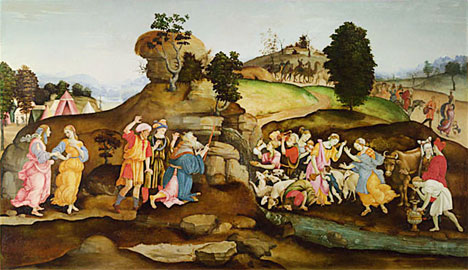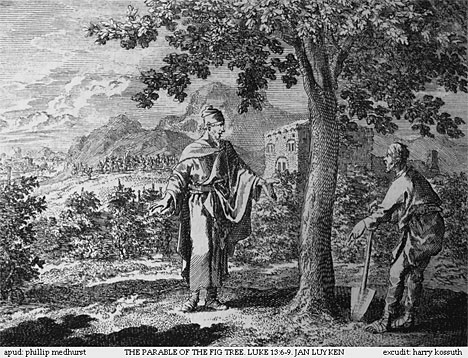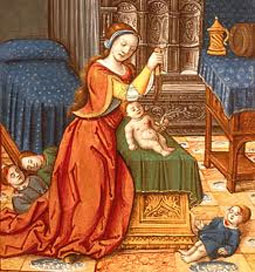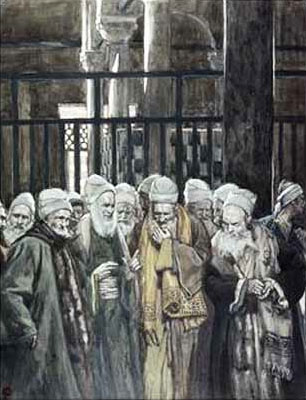Aug
23
2010
Psalm 114 – Family of Blood

Psalm 114 is one of those weird passages of Scripture that makes you wonder if the author was high on something. Without an understanding of the significance of the place of this song among these seven Psalms, the lyrics appear to be either the overly-clever, sophomoric crypticism of an ancient Bono or the fragmented derivatory prattlings of a madman.
Continue reading
4 comments | tags: Babel, Egypt, Literary Structure, Numbers, Peter Leithart, Psalms, Zechariah | posted in Bible Matrix, Biblical Theology
Aug
16
2010

Psalms 111 to 117 are the “Praise the Lord” psalms, an obvious unit due to the repetition of that phrase. Are they arranged in any order, or is there some internal logic going on? You know what I’m going to say next, don’t you?
Continue reading
2 comments | tags: Fractals, Literary Structure, Psalms | posted in Bible Matrix, Biblical Theology
Aug
14
2010

“Do you suppose that I came to give peace on earth? I tell you, not at all, but rather division.” Luke 12:51
Another weird idea James Jordan presents in his Revelation lectures is the premise that the famous Four Horsemen of the Apocalypse represent the gospel. As Uri Brito wrote a couple of years ago, first you think Jordan is nuts; then, as you continue to study, you think he is less nuts. Finally you give in and accept his genius, because his premise is vindicated by the similar use of the symbols in the Old Testament, and the literary structure of the event.
Continue reading
Comments Off | tags: AD70, Balaam, Herod, John, Literary Structure, Numbers, Revelation, Systematic typology, Zechariah | posted in Bible Matrix, Biblical Theology, The Last Days, The Restoration Era
Aug
11
2010
The Art of Interpretation

Oh, the depth of the riches and wisdom and knowledge of God! How unsearchable are his judgments and how inscrutable his ways! (Romans 11:33)
Hermeneutics is a big word you learn at Bible College. It is the study or practice of interpreting texts in the areas of literature, law and religion.
In literature, discovering the intent of an author can be an enlightening game. In law, one’s life (or life sentence) can hang in the balance of a judge’s interpretation. In religion, besides plumbing the depths of the mind of God, it is an enlightening game in the balance of which many lives hang. God has revealed His mind in His Word, and has also seen fit to give to His people the often difficult job of interpreting it.
[This post has been refined and included in Sweet Counsel: Essays to Brighten the Eyes.]
Continue reading
Comments Off | tags: Ezekiel, Hermeneutics, John, Literary Structure, Revelation, Timothy, Typology, Warren Gage | posted in Biblical Theology
Aug
9
2010
An Exhortation to Be A Fruitful Tree

Tabernacles was the final annual feast, a Godfest to be thrown by Jews as a ministry to Gentiles. At the Feast of Clouds [1], every household temporarily became a new house of God, a “local branch” of the Tabernacle, a “priesthood of all believers.” Of course, we see this fulfilled in the book of Acts. Just as we see Paul exhort the Ephesians (Gentiles!) to put on the mediatorial body-armour of the High Priest, [2] his final exhortation to the Roman Christians alludes to not only Israel’s feasts but Israel’s priesthood. Pretty much every church he established was a “booth” made of natural Jewish branches and ingrafted Gentile branches. [3] At Pentecost, the same cloud that received Jesus filled the house. [4] Now every household of faith was a Tabernacle, a glorious cloud with a government of human angel-elders. [5] In the Bible’s literary structure, a recurring motif at Tabernacles is good fruit, godly offspring. God wants more than just a covering of leaves. As in Eden, future generations hang upon wise government.
Continue reading
8 comments | tags: AD70, Add new tag, Atonement, Doug Wilson, Feasts, Genesis, Laver, Literary Structure, Paul, Roman Catholicism, Romans, Systematic typology, Tabernacles, Temple | posted in Bible Matrix, Biblical Theology, The Last Days
Aug
4
2010
 .
.
Some more thoughts on New Covenant Virility.
The minute details of the Bible matter. What was the Ethiopian eunuch, keeper of the queen’s treasure, reading, and why? In sacred history there are no accidents.
Isaiah 53 is about the barrenness and woundedness of God’s Man. He is circumcision epitomised. Like a eunuch, He is judged by men as unfit for Tabernacle service, judged in the gates (kingdom doors shut) and sent outside the city. He is “stricken,” or afflicted with stroke, God’s “lash” of plague, as unacceptable-for-priesthood as a leper.
“…and who will declare His generation?” Here is an important detail. What does this mean?
Continue reading
Comments Off | tags: Abraham, Acts, Athaliah, Baptism, Haman, Isaiah, Literary Structure, Tabernacle, Temple | posted in Bible Matrix, Biblical Theology, The Restoration Era
Aug
3
2010

A lot of very smart Christians believe that the Creation account was written as a foil for Ancient Near Eastern creation myths. It was written by Moses to rally Israel culturally, to set a boundary between the Hebrew identity and that of the nations.
Continue reading
Comments Off | tags: Genesis, James Jordan, Literary Structure | posted in Bible Matrix, Biblical Theology, Creation, Quotes
Jul
30
2010

Art is man’s interpretation of the world, but the world itself is the original art. Everything is physical, literal, historical, but everything is also symbol. This is not an interpretation imposed upon what we observe. The Creation was actually made as symbol. Without the Word of God, we are rendered unable to interpret it. [1]
The meaning of the sun, moon and stars in Genesis 1 is not simply a poetic idea. The purpose of the heavenly lights is actual and practical. Moreover, it will be measured out in human flesh over and again throughout history.
Continue reading
Comments Off | tags: Abel, Animism, Cain, Creation Week, Genesis, Literary Structure, Marilynne Robinson | posted in Biblical Theology, Creation, Quotes
Jul
1
2010

As I’ve mentioned here before, and in Totus Christus, the reference to the “man of sin” in Revelation is the sixth stanza of what is usually a seven stanza format. Only, in the case of this “Adam,” his seventh stanza is missing. [1] There is no Shekinah, no rest, no transfiguration, no bestowed glory. He crowned himself, so for him there would be no true crown.
Continue reading
Comments Off | tags: AD70, antichrist, Ark of the Covenant, Corinth, Covenant Theology, Herod, Literary Structure, Man of sin, Paul, Systematic typology | posted in Bible Matrix, Biblical Theology, Ethics, The Last Days, Totus Christus
May
13
2010

or Jesus, the Destroying Angel
James Jordan says the Revelation is like one of those old human anatomy teaching aids, the ones with layers of acetate. One starts with the skeleton and overlays the nervous system, arteries, organs, etc. They are all connected and yet each is a system that is individually identifiable. This is literature that is irreducibly complex.
Continue reading
1 comment | tags: AD70, Creation Week, James Jordan, Jericho, Jezebel, John, Lampstand, Literary Structure, Revelation, Totus Christus | posted in Biblical Theology



































